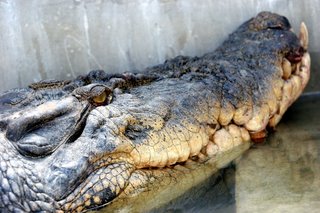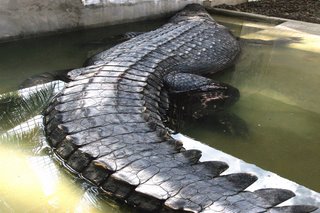

 The 15-footer female crocodile captured by villagers in Siay town in Zamboanga Sibugay province in southern RP is now in police care in Zamboanga City. (Zamboanga Journal)
The 15-footer female crocodile captured by villagers in Siay town in Zamboanga Sibugay province in southern RP is now in police care in Zamboanga City. (Zamboanga Journal) ZAMBOANGA CITY (Zamboanga Journal / 23 May) Villagers captured a 15-foot crocodile on a mangrove area in the southern Philippine province of Zamboanga Sibugay, police said Tuesday.
Police said it took custody of the reptile captured last week in the coastal town of Siay, about 150 km east of Zamboanga City.
Police said it took custody of the reptile captured last week in the coastal town of Siay, about 150 km east of Zamboanga City.
"We are temporarily taking care of the reptile and would hand it over to environment officials whenever they are ready," Chief Superintendent Jaime Caringal, the regional police commander, told the Zamboanga Journal.
The crocodile bore hack wounds on its thick armor, but it did not pose any danger to the life of the animal.
It was the first time that a wild crocodile was captured in the area, although smaller crocs can be found in many wild habitats on Mindanao. The huge reptile was placed in a caged pond inside a police camp in Zamboanga City.
Small crocodiles feed on fish and small aquatic animals, while larger ones also catch land mammals and birds that approach the water. Members of some large species sometimes attack and eat humans.
The crocodile bore hack wounds on its thick armor, but it did not pose any danger to the life of the animal.
It was the first time that a wild crocodile was captured in the area, although smaller crocs can be found in many wild habitats on Mindanao. The huge reptile was placed in a caged pond inside a police camp in Zamboanga City.
Small crocodiles feed on fish and small aquatic animals, while larger ones also catch land mammals and birds that approach the water. Members of some large species sometimes attack and eat humans.
The female crocodile lays her eggs, usually about 20 in number, in a nest of rotting vegetation or in a shallow pit on the river bank, and digs them up when she hears them hatching.
In most species the average adult length is between 6 and 10 feet. Saltwater crocodile is the largest and often measures 14 feet long and may exceed 20 feet. The smallest crocodile -- the Congo dwarf -- averages 3 feet.
The crocodile skins -- used for leather bags, shoes and belts and other fashion accessories -- are widely sought after in international market, while the reptile's meat is considered a delicacy and usually cooked as steaks in some countries and its internal organs are believed to have aphrodisiac properties.
3 comments:
Interesting! This particular specie must be on the way to extinction. However, there is a certain specie that thrives in the Batasan Pambansa called "BUWAYA." They are even more dangerous than the specie shown in this photo due to their ability to suck the blood out of the Filipinos and leaving them emaciated to the point of death while they fatten themselves.
Dear Anonymous,
Ha ha ha I'll bet that a lot of Filipinos would agree to that. Thanks for visiting the site.
Mabuhay!
Ed.Zamboanga Journal
Post a Comment